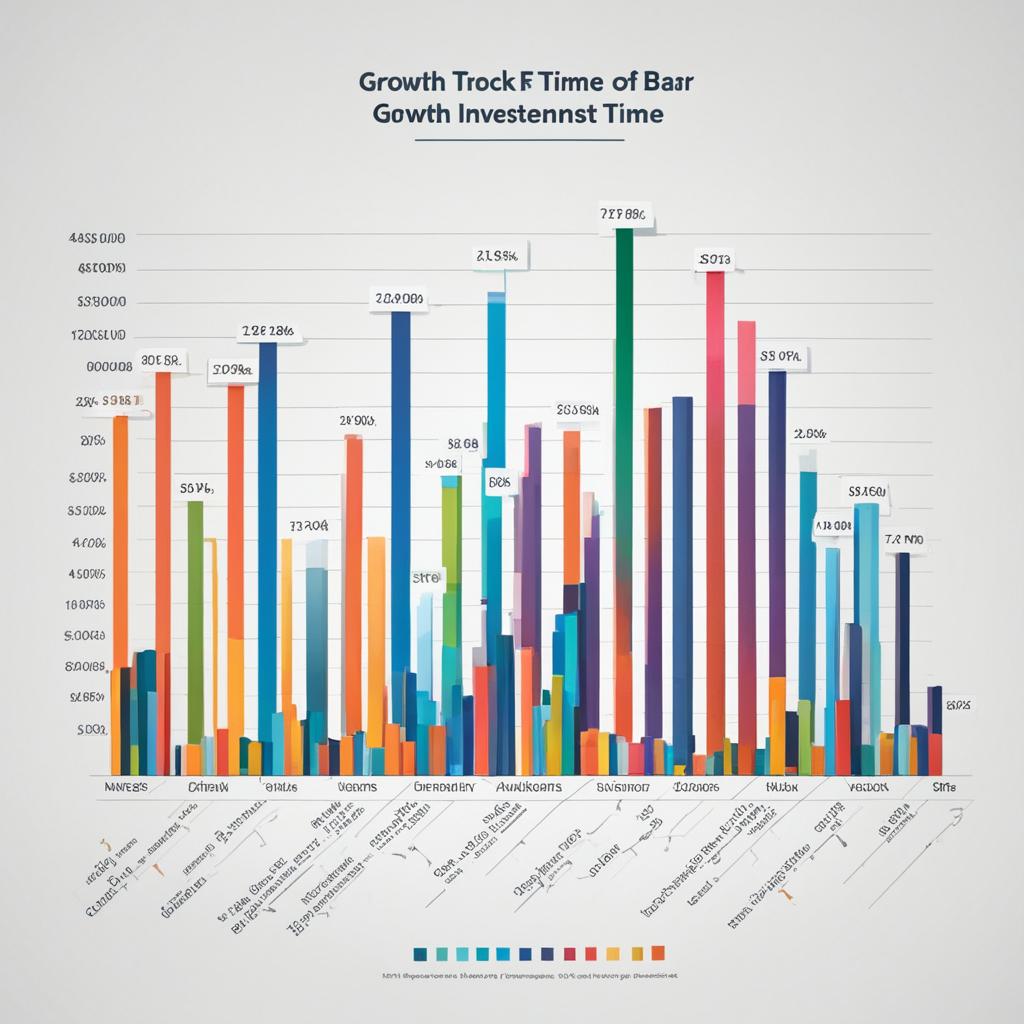If you have $30k and want to invest it wisely, this comprehensive guide will provide you with the top investment options, strategies, and tips to maximize your returns. Whether you’re planning for the short or long term, this guide will help you make informed decisions to reach your financial goals.
Investing $30k is a significant opportunity to grow your wealth and achieve your financial goals. By utilizing the various investment options discussed in this guide and considering your personal circumstances, risk tolerance, and time horizon, you can make informed decisions to make the most of your investment and secure a better financial future.
Now let’s dive into the different investment options and strategies you can consider to invest your $30k wisely:
Key Takeaways:
- Investing $30k requires careful planning and consideration
- Diversify your investment portfolio to minimize risk
- Consider your investment goals, risk tolerance, and time horizon
- Regularly review and adjust your investments based on market conditions
- Maximize your returns by focusing on long-term growth
Real Estate Investments
Real estate can be an excellent option for investing your $30k. With various strategies and opportunities available, you can leverage your funds and potentially generate income or profits. Let’s explore some of the ways you can invest in real estate:
1. Real Estate Partnerships
Consider partnering with other investors to pool your resources and invest in properties together. This can help you access larger and more profitable real estate deals that may be out of reach individually. By working with experienced partners, you can benefit from their expertise and minimize your risk.
2. Crowdfunding
Crowdfunding platforms allow you to invest in real estate projects alongside other investors. With lower minimum investment requirements, crowdfunding provides an accessible way to diversify your portfolio. You can choose from different types of properties and investment structures based on your risk tolerance and investment goals.
3. House Hacking
If you’re open to living in the property you invest in, house hacking can be a smart strategy. By purchasing a multi-unit property, such as a duplex or triplex, you can live in one unit while renting out the others. The rental income can help cover your mortgage, reducing your housing expenses and potentially generating cash flow.
“Real estate cannot be lost or stolen, nor can it be carried away. Purchased with common sense, paid for in full, and managed with reasonable care, it is about the safest investment in the world.” – Franklin D. Roosevelt
4. Home Renovations/Flipping Houses
If you have a knack for home renovations or are willing to learn, flipping houses can be a profitable venture. By purchasing properties in need of improvement, you can increase their value through renovations and sell them for a higher price. This strategy requires careful market analysis, budgeting, and project management skills.
Real estate investments offer the potential for regular income through rental properties and long-term appreciation as property values increase. However, it’s important to conduct thorough due diligence, understand the risks involved, and consider factors such as location, market trends, and property management.
Next, we’ll explore another investment option: index fund investments.
Index Fund Investments
When it comes to investing your $30k, index funds provide a passive and low-cost option that can help you build a diversified portfolio for long-term growth. These funds track market indexes, such as the S&P 500, allowing you to benefit from the overall performance of the market without the need for active management.

By investing in index funds, you can take advantage of the growth potential of a wide range of companies across different sectors. This helps spread your investment risk and reduce the impact of any individual stock’s performance on your portfolio. Rather than trying to beat the market, index fund investments focus on matching the performance of the underlying index.
Passive investing through index funds is an effective strategy for investors who prefer a hands-off approach. These funds require minimal management, saving you time and effort. Additionally, index funds generally have lower fees compared to actively managed funds, making them a cost-effective choice for your investment dollars.
With an index fund, you’re essentially investing in the collective performance of a basket of stocks. This means that the success or failure of a single company doesn’t have a significant impact on your overall investment. Instead, you’re participating in the broader market trends and long-term growth.
To illustrate the benefits of index fund investments, consider the performance of the S&P 500 index over the last several decades. As seen in the table below, the index has consistently generated positive returns over the long term, despite short-term fluctuations.
| Year | S&P 500 Return |
|---|---|
| 2015 | 1.38% |
| 2016 | 11.96% |
| 2017 | 21.83% |
| 2018 | -4.38% |
| 2019 | 31.49% |
“Investing in index funds allows you to participate in the overall growth of the market while minimizing risk and expenses. It’s a simple and reliable way to grow your investment over time.” – John Smith, Financial Advisor
If you’re looking for a low-maintenance investment option that can help you achieve long-term financial goals, consider index fund investments. With their passive nature and ability to provide diversification, these funds offer a solid foundation for building your investment portfolio.
Stock and ETF Investments
When it comes to investing your $30k, exploring stock and exchange-traded fund (ETF) options can be a viable strategy. With a wide range of individual stocks and ETFs available, you have the opportunity to tailor your investments to align with your specific goals and risk tolerance.
If you seek an aggressive growth strategy, investing in individual stocks can offer you the potential for significant returns. By carefully selecting stocks of companies with strong growth prospects, you can take advantage of their success and increase the value of your investment.
On the other hand, if you prefer a more passive and diversified approach, ETFs can be an excellent choice. ETFs are investment funds that trade on stock exchanges, offering exposure to a wide range of securities within a single investment. By investing in ETFs, you can gain access to multiple stocks and industries, spreading your risk and potentially earning steady returns.
Diversification is a key consideration when investing in stocks and ETFs. By spreading your investments across different sectors and markets, you can reduce the impact of any single stock’s performance on your overall portfolio.
It’s important to note that investing in individual stocks requires careful research and analysis. Evaluating a company’s financials, growth potential, and competitive advantage can help you make informed investment decisions. Alternatively, investing in ETFs provides instant diversification and professional management, making it a more passive and hands-off strategy.

By blending individual stock investments with ETFs, you can create a well-rounded portfolio that combines growth potential and risk diversification. It’s always wise to consider your investment goals, risk tolerance, and the time you can commit to managing your investments before making any decisions.
REIT Investments
Real Estate Investment Trusts (REITs) offer a unique opportunity to invest in real estate without directly owning and managing properties. As an investor, you can benefit from the income generated by commercial investment properties, including office buildings, shopping centers, and apartment complexes.
REITs provide a hassle-free way to diversify your investment portfolio and potentially earn regular dividends. By pooling money from various investors, REITs acquire and manage a diverse range of properties. This allows individual investors to access real estate investments that may have been otherwise out of reach.
One advantage of investing in REITs is the potential for consistent income through dividends. By law, REITs must distribute at least 90% of their taxable income to shareholders in the form of dividends. This can provide you with a reliable income stream as a real estate investor.
Furthermore, REITs offer the potential for capital appreciation as property values increase over time. When you invest in a REIT, you indirectly participate in the appreciation of the real estate portfolio. This can lead to potential long-term growth and higher returns on your investment.
It’s important to note that REITs are traded on major stock exchanges, just like stocks. This means you can buy and sell REIT shares easily, providing liquidity compared to investing directly in real estate properties. However, the value of REIT shares can also fluctuate based on market conditions.
If you’re interested in REIT investments, consider the following types of REITs:
- Equity REITs: These REITs own and operate income-generating properties, such as office buildings, shopping centers, and apartments. They generate income from rental payments and property appreciation.
- Mortgage REITs: These REITs invest in real estate mortgages and earn income from interest payments. They don’t own physical properties but instead provide financing for real estate transactions.
- Hybrid REITs: These REITs combine elements of equity and mortgage REITs, investing in both physical properties and real estate loans.
To help you understand the potential benefits of investing in REITs, take a look at the following table:
| Advantages of REIT Investments | Considerations |
|---|---|
| 1. Access to diversified real estate investments | 1. Share price volatility |
| 2. Potential for regular dividends | 2. Market risk affecting property values |
| 3. Liquidity compared to direct property ownership | 3. Interest rate risk for mortgage REITs |
| 4. Indirect participation in property appreciation |
By carefully considering the advantages and considerations associated with REIT investments, you can make an informed decision about including them in your investment portfolio.

Next, let’s explore another investment option: Mutual Fund Investments.
Mutual Fund Investments
When it comes to diversifying your $30k investment, mutual funds can be an excellent choice. These funds are actively managed by professional portfolio managers who carefully select a mix of assets across various sectors and industries. By investing in mutual funds, you gain access to a diversified portfolio that can help reduce risk and potentially maximize returns.
Mutual funds are designed to provide you with exposure to different asset classes, such as stocks, bonds, and cash equivalents, all within a single investment. This diversification spreads your risk across multiple investments, making mutual funds a suitable option for investors looking to mitigate potential losses.
One key advantage of mutual funds is the professional management they offer. Experienced fund managers closely monitor market trends, economic conditions, and individual securities, making informed decisions to optimize your portfolio’s performance. Their expertise allows them to react quickly to changing market conditions and potentially capitalize on opportunities.
It’s important to consider the costs associated with investing in mutual funds. While many funds have expense ratios, which cover the fund’s operating expenses, some funds also charge sales fees (known as load fees) when you buy or sell shares. These fees can vary depending on the fund and should be carefully evaluated before investing.
“Mutual funds offer investors the opportunity to benefit from professional portfolio management and diversification across multiple asset classes.” – [Your Name], Financial Advisor
Types of Mutual Funds
Mutual funds come in various types, each offering different investment strategies and objectives. Here are some common types of mutual funds:
- Equity Funds: These funds invest primarily in stocks and aim for long-term capital appreciation.
- Bond Funds: Bond funds buy and hold bonds, generating income through interest payments.
- Money Market Funds: Money market funds invest in low-risk, short-term debt securities and provide stable returns.
- Index Funds: Index funds track a specific market index, such as the S&P 500, and replicate its performance.
- Asset Allocation Funds: These funds allocate investments across multiple asset classes, making them suitable for diversified portfolios.
Before selecting a mutual fund, consider your investment goals, risk tolerance, and time horizon. Each fund has a specific investment strategy and may be more suitable for certain individuals.
| Advantages of Mutual Fund Investments | Disadvantages of Mutual Fund Investments |
|---|---|
|
|
By carefully considering your investment goals and understanding the advantages and disadvantages of mutual funds, you can make informed decisions about including them in your investment portfolio.
Overall, mutual funds offer investors an opportunity to diversify their $30k investment and benefit from professional portfolio management. With a range of options available, you can find a mutual fund that aligns with your investment goals and risk tolerance. Just remember to carefully evaluate the fund’s expenses, performance history, and investment strategy before making any investments.
Alternative Asset Investments
If you’re looking to diversify your $30k investment, consider exploring alternative asset investments. These unique investment options offer the potential for growth and potentially higher returns. However, it’s important to note that they also come with their own risks and require thorough research and understanding before diving in.
Cryptocurrency
Cryptocurrency has gained significant popularity in recent years, with digital currencies like Bitcoin and Ethereum making headlines. Investing in cryptocurrency can be highly volatile but can also offer substantial returns if approached with caution. It’s important to stay updated on the latest market trends and ensure you have a secure digital wallet for storing your investments.
Art
Investing in art can be a creative way to diversify your portfolio. From exquisite paintings to sculptures and photography, art holds the potential for both aesthetic pleasure and financial growth. However, investing in art requires a keen eye for quality, knowledge of the market, and an understanding of the art world’s intricacies.
Farmland
Investing in farmland can provide a stable and tangible asset to your investment portfolio. As the world’s population continues to grow, the demand for food and agricultural products is expected to rise. Investing in farmland allows you to participate in this sector and potentially earn income from leasing the land to farmers or from the appreciation of the property itself.
Small Business Start-ups
Investing in small business start-ups offers the opportunity to support aspiring entrepreneurs and potentially reap financial rewards. This can be done through direct investments or by participating in crowdfunding campaigns through platforms like Kickstarter and Indiegogo. When considering small business investments, it’s vital to conduct thorough due diligence and assess the business’s long-term prospects.
Alternative asset investments can bring diversity to your portfolio and provide unique investment opportunities. While they require careful consideration and research, they can be a valuable addition to your investment strategy.

A Fixed-Income Investment
When it comes to investing your hard-earned dollars, it’s crucial to consider a balanced portfolio that includes a fixed-income investment. This type of investment offers stability and conservative growth, making it an excellent choice for investors looking to mitigate risk while still earning returns.
Exploring Fixed-Income Options
There are several fixed-income options to consider, each with its own unique advantages and characteristics. Here are three popular choices:
- Bonds: Bonds are debt securities that issuers, such as governments and corporations, use to raise capital. When you invest in bonds, you lend money to the issuer in exchange for periodic interest payments and the return of the principal when the bond matures. Bonds can provide a steady stream of income and are available in various types, including government bonds, corporate bonds, and municipal bonds.
- Certificates of Deposit (CDs): CDs are time deposits offered by banks and credit unions. When you invest in a CD, you agree to leave your money with the financial institution for a specific period, known as the maturity term. In return, you earn a fixed interest rate throughout the duration of the CD. CDs typically offer higher interest rates than regular savings accounts and are a low-risk investment option.
- High-Yield Savings Accounts: High-yield savings accounts are accounts offered by banks that provide higher interest rates compared to traditional savings accounts. These accounts allow you to earn interest on your money while keeping it easily accessible. High-yield savings accounts are a safe and flexible option for individuals looking to preserve their capital while earning competitive returns.
Choosing the Right Fixed-Income Assets
When selecting fixed-income assets, it’s essential to consider your investment goals and time horizon. For example, if you’re looking for steady income and are willing to take on moderate risk, bonds can be an attractive option. On the other hand, if you’re focused on short-term savings with minimal risk, CDs and high-yield savings accounts may be more suitable.
Ultimately, diversifying your investment portfolio by including fixed-income assets can help balance out the potential volatility of other investments, such as stocks or alternative assets. It’s wise to consult with a financial advisor to determine the best fixed-income strategy based on your individual circumstances.
| Asset | Risk Level | Expected Returns | Liquidity |
|---|---|---|---|
| Bonds | Low to Moderate | Varies depending on bond type | Moderate |
| Certificates of Deposit (CDs) | Low | Fixed interest rates | Medium |
| High-Yield Savings Accounts | Low | Varies by bank | High |
Note: The above table provides a general overview and comparison of the three fixed-income asset options, considering their risk level, expected returns, and liquidity. Individual rates and terms may vary depending on the specific financial institution and current market conditions.
By incorporating fixed-income investments into your portfolio, you can achieve a balance between risk and stability, ensuring that your investments work together to help you reach your financial goals. Remember, consult with a financial professional to make personalized investment decisions based on your unique situation.
Robo Advisor Investments
When it comes to investing your $30k, robo advisors can be a game-changer. These automated platforms utilize advanced technology and algorithms to manage your investment portfolio efficiently. With robo advisor investments, you can enjoy the benefits of passive investing and goal-based strategies.
Robo advisors consider your financial goals, risk tolerance, and timeline to create a personalized investment strategy. By funding your account and setting up regular contributions, you can sit back and relax while the robo advisor takes care of your investments. These platforms make investment decisions, rebalance your portfolio, and ensure that your investments align with your goals.
One of the significant advantages of robo advisor investments is the passive investing approach. They typically use low-cost index funds or exchange-traded funds (ETFs) to build your portfolio. By diversifying your investments across various asset classes, robo advisors help minimize risk and maximize long-term growth.
“Robo advisors take the guesswork out of investing by automating portfolio management and rebalancing, allowing you to stay on track with your financial goals.”
Not only are robo advisors convenient and time-saving, but their fees are also generally lower compared to traditional financial advisors. This makes them a cost-effective option, especially for investors with a limited budget, like investing $30k.
By leveraging the power of technology, robo advisors offer a user-friendly and intuitive interface that allows you to monitor your investments and track your progress. You can access your account anytime, anywhere, giving you full control and transparency over your investments.
Robo advisor investments are ideal for individuals who prefer a hands-off approach and want their investments to align with their financial goals. Whether you’re saving for retirement, a down payment on a home, or your child’s education, robo advisors can help optimize your investment strategy and guide you towards success.
Comparison of Top Robo Advisor Platforms
| Robo Advisor | Minimum Investment | Management Fee | Features |
|---|---|---|---|
| Betterment | $0 | 0.25% – 0.40% | Automated portfolio management, tax-loss harvesting, goal-based investing |
| Wealthfront | $500 | 0.25% + fund fees | Passive investing, tax optimization, financial planning tools |
| Ellevest | $0 | 0.25% – 0.50% | Gender-specific investing, goal-based planning, retirement savings |
Table: A comparison of top robo advisor platforms
These are just a few examples of popular robo advisor platforms available in the market. Each platform may offer unique features and benefits, so it’s essential to do thorough research and choose the one that aligns with your investment goals and preferences.
With robo advisor investments, you can harness the power of technology and passive investing to grow your $30k. It’s important to keep in mind that while robo advisors provide automated investment solutions, it’s always a good idea to evaluate your investments periodically and make adjustments as needed to stay on track with your financial goals.
College Education
If you have children, investing part of your $30k in their college education can be a wise choice.
Consider opening a 529 savings plan, which offers tax advantages and allows your funds to grow tax-deferred.
If your child doesn’t go to college, you can transfer the funds to another child or use them for qualified educational expenses in the future.
Why Invest in College Education?
Investing in college education is an investment in your child’s future. By saving for their education, you can help alleviate the burden of student loans and set them up for success.
“Education is the most powerful weapon which you can use to change the world.” – Nelson Mandela
With the rising costs of tuition, it’s essential to start saving early. By putting aside part of your $30k into a dedicated college fund, you can ensure that your child has the financial resources they need to pursue higher education.
529 Savings Plan: A Tax-Advantaged Option
One of the most popular ways to save for college education is through a 529 savings plan. This plan provides several tax advantages and flexibility for your investment.
Here are some key benefits of a 529 savings plan:
- Tax-deferred growth: The funds in your 529 savings plan grow tax-free, allowing your investment to potentially accumulate more over time.
- Tax-free withdrawals: When you use the funds for qualified educational expenses, the withdrawals are tax-free, providing you with additional savings.
- State tax benefits: Some states offer tax deductions or credits for contributions made to a 529 savings plan, further maximizing your savings.
- Flexibility: If your child decides not to pursue college or receives a scholarship, you can transfer the funds to another eligible family member without penalty.
Planning for a Bright Future
| Benefit | Description |
|---|---|
| Tax advantages | A 529 savings plan offers tax-deferred growth and tax-free withdrawals for qualified educational expenses. |
| Flexibility | If your child doesn’t go to college, you can transfer the funds to another family member or use them for qualified educational expenses in the future. |
| Lower student loan debt | By saving for your child’s education, you can help reduce their reliance on student loans and set them up for a stronger financial future. |
Investing in your child’s college education is a long-term investment that can provide them with opportunities for personal and professional growth. By taking advantage of tax-advantaged options like a 529 savings plan, you can make the most of your $30k and help secure a brighter future for your child.
Considerations Before You Invest $30k
Before embarking on your investment journey with $30k, it’s crucial to take several important factors into account. By carefully considering your investment timeframe, risk tolerance, emergency fund, strong savings habits, and current life stage, you can make informed decisions that align with your financial goals.
Determine Your Investment Timeframe
First and foremost, I recommend determining your investment timeframe. Are you looking for short-term gains or long-term growth? Your timeframe will influence the type of investments you should consider and the level of risk you can tolerate. For example, if you have a longer investment horizon, you may be more comfortable with aggressive growth strategies. On the other hand, if you’re planning to use the funds in the near future, a more conservative approach may be prudent.
Assess Your Risk Tolerance
Understanding your risk tolerance is crucial when investing $30k. Consider how comfortable you are with potential fluctuations in the market and the possibility of temporary losses. Investment options vary in terms of risk, ranging from low-risk fixed-income assets to higher-risk stocks and alternative investments. Assess your risk tolerance honestly and choose investments that align with your comfort level.
Build a Solid Emergency Fund
Before investing a significant amount like $30k, it’s essential to have a strong emergency fund in place. An emergency fund acts as a safety net to cover unexpected expenses or income disruptions. Aim to save three to six months’ worth of living expenses in a readily accessible account, like a high-yield savings account or a money market fund. This fund will provide peace of mind and financial security, allowing you to invest your $30k with confidence.
Establish Strong Savings Habits
Investing $30k is a great opportunity to enhance your financial well-being, but it’s also important to develop strong savings habits. Ensure you have a budget in place and commit to consistently saving a portion of your income. By maintaining disciplined savings habits, you can continue to grow your investment portfolio and achieve your long-term financial goals.
Consider Your Current Life Stage
Last but not least, consider your current life stage when making investment decisions. Are you in the early stages of your career, planning for retirement, or raising a family? Your life stage can impact your investment goals, risk tolerance, and the level of liquidity you require. Take the time to evaluate how your $30k investment aligns with your current needs and future plans.
By addressing these key considerations before investing your $30k, you’ll set a solid foundation for a successful investment journey. Remember, everyone’s financial situation is unique, so it’s essential to make decisions that align with your individual circumstances and aspirations.
Final Thoughts on How to Invest 30K
Investing $30k can be an exciting opportunity to grow your wealth and secure a better financial future. To make the most of your investment, it’s important to implement effective strategies that maximize returns and promote long-term growth. By diversifying your portfolio and maintaining a focus on long-term goals, you can increase your chances of success and mitigate risks along the way.
Investing Strategies
When investing $30k, it’s crucial to adopt strategies that align with your financial goals and risk tolerance. Here are a few key strategies to consider:
- Asset Allocation: Diversify your investments across different asset classes to spread risk and potentially maximize returns.
- Buy and Hold: Invest with a long-term mindset, avoiding frequent buying and selling that can lead to higher costs and potential losses.
- Systematic Investing: Invest a fixed amount at regular intervals, taking advantage of dollar-cost averaging and reducing the impact of market volatility.
- Research and Analysis: Thoroughly research potential investments, keeping a close eye on market trends and analyzing the fundamentals of companies or assets.
Maximizing Returns
When aiming to maximize returns on your $30k investment, consider the following:
- Compound Interest: Look for investment opportunities that offer compounding benefits, allowing your money to grow over time.
- Reinvest Dividends: If investing in dividend-paying stocks or funds, consider reinvesting the dividends to buy more shares and boost your returns.
- Regular Monitoring: Regularly review the performance of your investments and make necessary adjustments to optimize your returns.
- Tax Efficiency: Structure your investments in a tax-efficient manner, utilizing accounts such as IRAs or 401(k)s to minimize tax liabilities.
Long-Term Growth and a Diversified Portfolio
When investing $30k, focusing on long-term growth is essential for building lasting wealth. Additionally, maintaining a diversified portfolio can help spread risk and potentially enhance returns. Consider allocating your funds across various asset classes, such as stocks, bonds, real estate, and alternative investments.
A diversified portfolio can help cushion the impact of market fluctuations and ensure that you’re exposed to different areas of the economy. Keep in mind the importance of periodically rebalancing your portfolio to maintain your desired asset allocation.
Remember, investing involves risks, and it’s important to conduct thorough research and consult with a financial advisor before making any investment decisions. Additionally, it’s crucial to stay informed about market trends and economic conditions, as these factors can influence the performance of your investments.
In conclusion, by implementing sound investing strategies, maximizing returns, and maintaining a long-term perspective with a diversified portfolio, you can make your $30k investment work harder for you and potentially achieve your financial goals.
Conclusion
Investing $30k is an exciting opportunity to grow your wealth and reach your financial goals. Throughout this comprehensive guide, we have explored various investment options that can help you make the most of your investment. By considering your personal circumstances, risk tolerance, and time horizon, you can make informed decisions that align with your financial objectives.
Remember, investing is a long-term commitment, and it’s important to regularly review and adjust your investments as needed. Stay informed about market trends and economic conditions to make informed choices. Diversifying your portfolio across different asset classes, such as real estate, index funds, stocks, and fixed-income investments, can help you maximize returns while managing risk.
Ultimately, the key to successful investing is having clear financial goals and a solid plan. Whether you’re saving for retirement, a child’s education, or financial independence, investing $30k is a step in the right direction. Take advantage of the investment options available, and with careful planning and discipline, you can secure a better financial future.
FAQ
What are some investment options for my k?
Some investment options for your k include real estate, index funds, stocks and ETFs, REITs, mutual funds, alternative assets, fixed-income investments, robo advisors, and college education plans.
How can I invest in real estate with k?
You can invest in real estate through options like real estate partnerships, crowdfunding, house hacking, or home renovations/flipping houses.
What are index fund investments?
Index fund investments are a passive and low-cost way to invest your k. They track market indexes like the S&P 500 and allow you to build a diversified portfolio.
How can I invest in stocks and ETFs?
You can invest in individual stocks or exchange-traded funds (ETFs) based on your investment goals and risk tolerance. Stocks offer a more aggressive growth strategy, while ETFs provide a passive approach.
What are REIT investments?
REIT investments are an indirect way to invest in real estate. By investing in REITs, you can benefit from income generated by commercial investment properties without direct property management.
What are mutual fund investments?
Mutual fund investments offer diversification across multiple asset classes. These actively managed funds provide professional portfolio management and a potentially lower risk compared to investing in individual stocks.
Which alternative assets can I invest in with k?
With k, you can consider alternative assets such as cryptocurrency, art, farmland, or small business start-ups. These investments have unique opportunities for growth but also come with their own risks and require thorough research.
What is a fixed-income investment?
A fixed-income investment, such as bonds, certificates of deposit (CDs), or high-yield savings accounts, provides stability and conservative growth with lower risk compared to stocks or alternative investments.
What are robo advisor investments?
Robo advisor investments offer a passive and goal-based approach. These platforms use technology and algorithms to manage your investment portfolio based on your financial goals, risk tolerance, and timeline.
How can I invest in my child’s college education?
You can open a 529 savings plan, which provides tax advantages and allows your funds to grow tax-deferred. If your child doesn’t attend college, you can use the funds for qualified educational expenses in the future or transfer them to another child.
What considerations should I keep in mind before investing k?
Before investing your k, consider your investment timeframe, risk tolerance, establish a solid emergency fund, develop strong savings habits, and take into account your current life stage.
How can I maximize my returns with a k investment?
You can maximize your returns by diversifying your investment portfolio, choosing the right investment strategies, and focusing on long-term growth. Regularly review and adjust your investments based on market conditions and changing financial circumstances.
What are some final thoughts on how to invest k?
By utilizing various investment options and considering your personal circumstances, risk tolerance, and time horizon, you can make informed decisions to maximize your investment potential and secure a better financial future.
What are some investment options for my k?
Some investment options for your k include real estate, index funds, stocks and ETFs, REITs, mutual funds, alternative assets, fixed-income investments, robo advisors, and college education plans.
Our Friends
- https://millennialmoney.com/how-to-invest-30k/
- https://www.goodfinancialcents.com/how-to-invest-30k/
- https://www.creditdonkey.com/invest-30k.html
Money posts:
 How to Invest $1 Million Dollars: Strategies and Tips for Growth and Security
How to Invest $1 Million Dollars: Strategies and Tips for Growth and Security
 12 Best Investments for 2024
12 Best Investments for 2024
 9 Best Investments for a Roth IRA (2024)
9 Best Investments for a Roth IRA (2024)
 12 Best Ways to Invest $5000 Dollars (2024)
12 Best Ways to Invest $5000 Dollars (2024)
 How to Invest in Index Funds: A Beginner’s Guide (2024)
How to Invest in Index Funds: A Beginner’s Guide (2024)
 How to Start Investing with Little Money (2024)
How to Start Investing with Little Money (2024)
 13 Best Compound Interest Accounts & Investments (2024)
13 Best Compound Interest Accounts & Investments (2024)
 Best Short-Term Investments for September (2024)
Best Short-Term Investments for September (2024)

